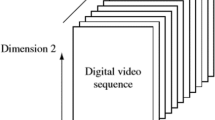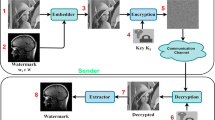Abstract
With the emergence and maturity of various signal processing tools, it can be more convenient, much faster and more arbitrary for people to illegally tamper the original video to varying degrees and in different forms, which makes the video authentication become the focus of researchers in multimedia field. This paper aims to improve the tampered area’s localization accuracy and maximize the degree of recovery for the tampered area, which are hot and difficult spots of research in video authentication. Firstly, a new non-negative matrix factorization method is proposed, which is implemented by setting different sparseness constraints on part of the basis matrix. Secondly, Hash function and the newly proposed method are used to generate the block-level watermark and frame-level watermark, which are self-embedded into the video, so as to authenticate the spatial tampering and temporal tampering separately. Finally, the intelligent characteristics of the basis matrix that the whole basis matrix can be recovered by the part and the spatial-temporal continuous characteristics of video are used to recover the tampered area. This paper’s contribution is that the tampered area’s localization accuracy and recovery quality are improved greatly compared with other similar methods. Experimental results show the effectiveness of this paper.














Similar content being viewed by others
References
Cai D, He X, Han J, Huang T (2011) Graph regularized nonnegative matrix factorization for data representation. IEEE Trans Pattern Anal Mach Intell 33(8):1548–1560
Chen S, Leung H (2008) Chaotic watermarking for video authentication in surveillance applications. IEEE Trans Circuits Syst Video Technol 18(5):704–709
El-Fouly T, El-Saadany E, Salama M (2007) Improved grey predictor rolling models for wind power prediction. IET Gener Transm Distrib 1(6):928–937
Hassan A, Ayoub A-H, Hasan Y, Wahab M, Michaelis B (2009) Secure block-based video authentication with localization and self-recovery. World Acad Sci Eng Technol 57:69–74
He H, Chen F, Tai H-M, Kalker T, Zhang J (2012) Performance analysis of a block-neighborhood-based self-recovery fragile watermarking scheme. IEEE Trans Inf Forensics Secur 7(1):185–196
Hoyer P (2004) Non-negative matrix factorization with sparseness constraints. J Mach Learn Res 5(9):1457–1469
Lee D, Seung H (2001) Algorithms for non-negative matrix factorization. Advances Neural Inform Proc Sys 13:556–562
Lin Y-C, Varodayan D, Girod B (2012) Image authentication using distributed source coding. IEEE Trans Image Process 21(1):273–283
Liu C (2009) Beyond Pixels: Exploring new representations and applications for motion analysis. Ph. D. thesis, Massachusetts Institute of Technology
Liu Z, Abbas A, Jing BY, Gao X (2012) WaVPeak: picking NMR peaks through wavelet-based smoothing and volume-based filtering. Bioinformatics 28(7):914–920
Lo C-C, Hu Y-C (2014) A novel reversible image authentication scheme for digital images. Signal Process 98:174–185
Shi Y, Qi M, Yi Y, Zhang M, Kong J (2013) Object based dual watermarking for video authentication. Optik 124(19):3827–3834
Stadlthanner K, Theis F, Puntonet C, Lang E (2005) Extended sparse nonnegative matrix factorization. In: Computational Intelligence and Bioinspired Systems. Springer Berlin Heidelberg, pp 249–256. doi: 10.1007/11494669_31
Tong M, Zhang W, Zhang J, Chen T (2012) A video watermarking framework resistant to super strong cropping attacks based on NMF with sparseness constraints on parts of the basis matrix. J Electron Inf Technol 34(8):1819–1826
Wang JJ-Y, Bensmail H, Gao X (2012) Multiple graph regularized protein domain ranking. BMC Bioinforma 13(1):307. doi:10.1186/1471-2105-13-307
Wang JJ-Y, Bensmail H, Gao X (2013) Joint learning and weighting of visual vocabulary for bag-of-feature based tissue classification. Pattern Recogn 46(12):3249–3255
Wang JJ-Y, Bensmail H, Gao X (2013) Multiple graph regularized nonnegative matrix factorization. Pattern Recogn 46(10):2840–2847
Wang JJ-Y, Wang X, Gao X (2013) Non-negative matrix factorization by maximizing correntropy for cancer clustering. BMC bioinforma 14(1):107. doi:10.1186/1471-2105-14-107
Xu D, Wang R, Wang J (2011) A novel watermarking scheme for H.264/AVC video authentication. Signal Process Image Commun 26(6):267–279
Yang Z, Zhou G, Xie S, Ding S, Yang J-M, Zhang J (2011) Blind spectral unmixing based on sparse nonnegative matrix factorization. IEEE Trans Image Process 20(4):1112–1125
Zhang W, Zhang R, Liu J, Wu C, Niu X, Yang Y (2013) A reversible fragile video watermarking for H.264/AVC. J Electron Inf Technol 35(1):106–112
Acknowledgment
This work was supported in part by National Natural Science Foundation of China (Grant No. 61072110), Natural Science Foundation of Shaanxi (Grant SJ08F15) and Science and Technology Overall Innovation Project of Shaanxi Province (Grant 2013KTZB03-03-03)
Author information
Authors and Affiliations
Corresponding author
Rights and permissions
About this article
Cite this article
Tong, M., Guo, J., Tao, S. et al. Independent detection and self-recovery video authentication mechanism using extended NMF with different sparseness constraints. Multimed Tools Appl 75, 8045–8069 (2016). https://doi.org/10.1007/s11042-015-2722-2
Received:
Revised:
Accepted:
Published:
Issue Date:
DOI: https://doi.org/10.1007/s11042-015-2722-2




